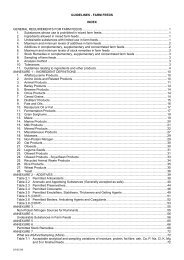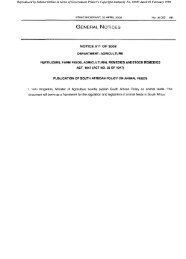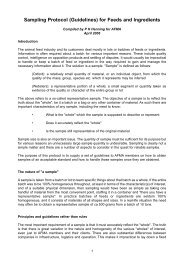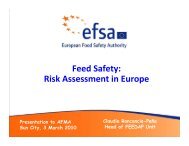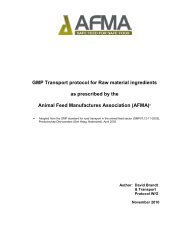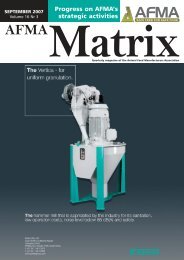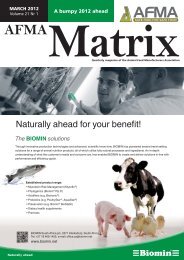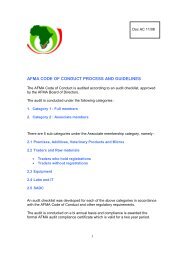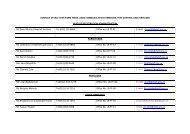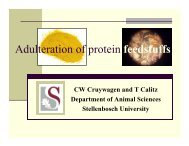You also want an ePaper? Increase the reach of your titles
YUMPU automatically turns print PDFs into web optimized ePapers that Google loves.
or as ratios) is difficult as we have to think<br />
multi-dimensional. The good news is that<br />
the vast majority of diets are deficient in<br />
both lysine and methionine. Thus, if we<br />
begin adding lysine sources, we will typically<br />
see an increase in milk production.<br />
At the same time, adding methionine first<br />
will typically result in an increase in both<br />
milk production and milk protein concentration.<br />
But these responses do not occur all the<br />
time. Why? First, it appears that there is a<br />
minimum milk protein concentration, and<br />
that is approximately 2,8% true protein (or<br />
about 3% crude protein). The relationship<br />
between milk protein yield and milk yield<br />
is nearly perfect (correlation coefficient of<br />
0,94). This makes a lot of sense given that<br />
several amino acids (namely methionine<br />
and cysteine) are required in the production<br />
of lactose.<br />
Thus, it appears the cow may regulate<br />
milk protein yield and milk yield very tightly<br />
to maintain a minimum milk protein to<br />
lactose relationship. At these low points,<br />
the response to either lysine or methionine<br />
could be substantial (3-10 litres milk reported).<br />
Regardless of the starting point, it<br />
appears that milk volume and milk protein<br />
concentration is maximised when lysine is<br />
supplied at 6,3 to 6,6% of metabolisable<br />
protein and methionine at 2,35 to 2,55% of<br />
metabolisable protein.<br />
Several studies from the early 1990s,<br />
and more recently research from the University<br />
of Illinois (Loor et al., 2011), demonstrate<br />
a health and production response.<br />
Methionine was supplemented during the<br />
pre-partum and fresh period. Incidence of<br />
fresh cow metabolic disease (namely ketosis<br />
and fatty liver) were reduced in excess<br />
of 50%. Cows fed the methionine supplemented<br />
diet increased dry matter intake<br />
faster and by day seven in milk, significant<br />
differences in milk production were reported.<br />
Based upon this research, we are recommending<br />
that at least 25g of metabolisable<br />
methionine should be supplied in the diet<br />
for pre-partum cows. Anecdotal evidence<br />
supports improved immune response in<br />
calves and heifers as well to amino acid<br />
formulation.<br />
Summary<br />
Amino acids are not additives and should<br />
not be thought of as such. They are critical<br />
building blocks of proteins and enzymes,<br />
and result in milk protein, volume, muscle<br />
and immunity. Nutritionists must evaluate<br />
diets for amino acid adequacy and forget<br />
meaningless numbers such as crude protein.<br />
The first step in amino acid formulation<br />
is maximising microbial yield from the rumen.<br />
This requires a good mix of fermentable<br />
carbohydrates, physically effective NDF<br />
and adequate degradable nitrogen to support<br />
microbial growth. The second step is<br />
to select the most economical sources of<br />
by-pass amino acids. This could be from<br />
soy-based products, blends of soy and<br />
sunflower, etc.<br />
And then work with your nutritionist<br />
to evaluate the different synthetic by-pass<br />
amino acids to achieve the desired levels<br />
of amino acids. These levels should be:<br />
for lactating cows, lysine > 6,1% MP and<br />
methionine greater than 2,1% MP; for the<br />
pre-partum cow, lysine > 6,1% MP and at<br />
least 25g total methionine. And finally,<br />
ingredients (such as sunflower, soy or any<br />
maize protein product) must be valued<br />
on an amino acid basis.<br />
<br />
Feed science<br />
<strong>AFMA</strong> MATRIX ● APRIL <strong>2013</strong> 51



